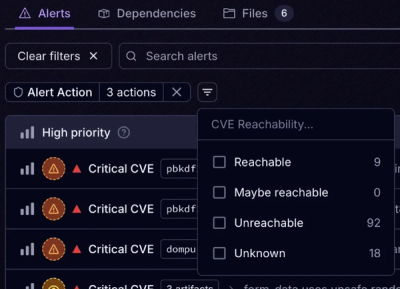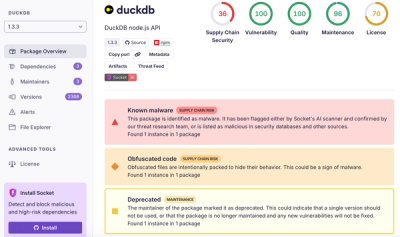
Security News
Feross on Risky Business Weekly Podcast: npm’s Ongoing Supply Chain Attacks
Socket CEO Feross Aboukhadijeh joins Risky Business Weekly to unpack recent npm phishing attacks, their limited impact, and the risks if attackers get smarter.
The extra
eis for...error
yarn add btreee
Start off by creating the root of your tree with a node. The root node must be one of leafNode, sequenceNode, selectorNode, inverterNode, or parallelNode.
Each "branch" of the tree must terminate with a leaf node that returns a STATUS.
Tree
btreeesequenceNode
STATUS.FAILURE.STATUS.SUCCESS is all nodes succeeded.STATUS.FAILURE if any node failed.selectorNode
STATUS.SUCCESS.STATUS.SUCCESS is any node succeeded.STATUS.FAILURE if all nodes failed.leafNode
STATUS.inverterNode
STATUS.parallelNode
STATUS.SUCCESSSTATUS.FAILUREimport { Tree, sequenceNode, selectorNode, leafNode, STATUS } from 'btreee'
const tree = new Tree()
// Set the root of the tree
tree.setRoot(
// Run everything in array until fail
() =>
sequenceNode(() => [
// If not hungry, fail and stop sequence
leafNode(() => (amIHungry() ? STATUS.SUCCESS : STATUS.FAILURE)),
// Run everything in array until fail
sequenceNode(() => [
// Run until a success
selectorNode(() => [
leafNode(() =>
isThereSomethingIReallyWant() ? STATUS.SUCCESS : STATUS.FAILURE,
),
leafNode(() => (isThereAnyFood() ? STATUS.SUCCESS : STATUS.FAILURE)),
leafNode(() => (areThereDrinks() ? STATUS.SUCCESS : STATUS.FAILURE)),
]),
// Only executes is previous node returned a success
leafNode(() => eatOrDrink() && STATUS.SUCCESS),
]),
]),
)
// Executes the tree
tree.tick()
Let's assume we have an EvilNPC we want to give some behivors to. Here is the interface:
type Direction = 'forward' | 'backward'
interface EvilNPC {
// Senses
getHealth: () => number // 0-100
feel: (
direction: Direction,
) => {
isEmpty: () => boolean
isWall: () => boolean
isUnit: () => boolean
getUnit: () => {
isEnemy: () => boolean
}
}
// Actions
walk: (direction: Direction) => void
attack: (direction: Direction) => void
pivot: () => void
heal: () => void
}
Our goal is to have this npc seek out and kill the player. The game world is very rudimentary, there's only forward and backward.
Here's what our basic tree would look like. Start reading from the bottom up to get a better understanding. Below is flowchart.
import { Tree, sequenceNode, selectorNode, leafNode, STATUS } from 'btreee'
const evilNpc: EvilNPC = new EvilNPC()
// NPC State
const state: {
health: number
direction: Direction
} = {
health: 100,
direction: 'forward',
}
// Simple Helper Functions
const isSomethingThere = (direction: Direction) =>
evilNpc.feel(direction).isEmpty() ? STATUS.FAILURE : STATUS.SUCCESS
const isSomethingInFrontOfMe = () => leafNode(() => isSomethingThere('forward'))
const isSomethingBehindMe = () => leafNode(() => isSomethingThere('backward'))
const isWallInFrontOfMe = () =>
sequenceNode(() => [
isSomethingInFrontOfMe(),
leafNode(() =>
evilNpc.feel('forward').isWall() ? STATUS.SUCCESS : STATUS.FAILURE,
),
])
const isUnitInFrontOfMe = () =>
sequenceNode(() => [
isSomethingInFrontOfMe(),
leafNode(() =>
evilNpc.feel('forward').isUnit() ? STATUS.SUCCESS : STATUS.FAILURE,
),
])
const isEnemyInFrontOfMe = () =>
sequenceNode(() => [
isUnitInFrontOfMe(),
leafNode(() =>
evilNpc.feel('forward').getUnit().isEnemy()
? STATUS.SUCCESS
: STATUS.FAILURE,
),
])
const isWallBehindMe = () =>
sequenceNode(() => [
isSomethingBehindMe(),
leafNode(() =>
evilNpc.feel('backward').isWall() ? STATUS.SUCCESS : STATUS.FAILURE,
),
])
const isUnitBehindMe = () =>
sequenceNode(() => [
isSomethingBehindMe(),
leafNode(() =>
evilNpc.feel('backward').isUnit() ? STATUS.SUCCESS : STATUS.FAILURE,
),
])
const isEnemyBehindMe = () =>
sequenceNode(() => [
isUnitBehindMe(),
leafNode(() =>
evilNpc.feel('backward').getUnit().isEnemy()
? STATUS.SUCCESS
: STATUS.FAILURE,
),
])
const shouldIHeal = () =>
leafNode(() => (state.health <= 25 ? STATUS.SUCCESS : STATUS.FAILURE))
// Leaf Nodes / Actions
const walk = (direction: Direction) =>
leafNode(() => (evilNpc.walk(direction), STATUS.SUCCESS))
const attack = (direction: Direction) =>
leafNode(() => (evilNpc.attack(direction), STATUS.SUCCESS))
const pivot = () => {
state.direction = state.direction === 'forward' ? 'backward' : 'forward'
return leafNode(() => (evilNpc.pivot(), STATUS.SUCCESS))
}
const heal = () => leafNode(() => (evilNpc.heal(), STATUS.SUCCESS))
// Sequences
const hunter = () =>
selectorNode(() => [
selectorNode(() => [isEnemyBehindMe(), attack('backward')]),
selectorNode(() => [isEnemyInFrontOfMe(), attack('forward')]),
])
const pivoter = () =>
selectorNode(() => [
sequenceNode(() => [isWallInFrontOfMe(), pivot()]),
sequenceNode(() => [isWallBehindMe(), pivot()]),
])
const walker = () => sequenceNode(() => [pivoter(), walk(state.direction)])
const healer = () => sequenceNode(() => [shouldIHeal(), heal()])
const actions = () => selectorNode(() => [hunter(), walker(), healer()])
const preActions = () =>
leafNode(() => ((state.health = evilNpc.getHealth()), STATUS.SUCCESS))
const root = () => sequenceNode(() => [preActions(), actions()])
const tree = new Tree()
tree.setRoot(root)
const tick = () =>
process.nextTick(() => {
tree.tick()
tick()
})
FAQs
> The extra `e` is for... `error`
We found that btreee demonstrated a not healthy version release cadence and project activity because the last version was released a year ago. It has 1 open source maintainer collaborating on the project.
Did you know?

Socket for GitHub automatically highlights issues in each pull request and monitors the health of all your open source dependencies. Discover the contents of your packages and block harmful activity before you install or update your dependencies.

Security News
Socket CEO Feross Aboukhadijeh joins Risky Business Weekly to unpack recent npm phishing attacks, their limited impact, and the risks if attackers get smarter.

Product
Socket’s new Tier 1 Reachability filters out up to 80% of irrelevant CVEs, so security teams can focus on the vulnerabilities that matter.

Research
/Security News
Ongoing npm supply chain attack spreads to DuckDB: multiple packages compromised with the same wallet-drainer malware.